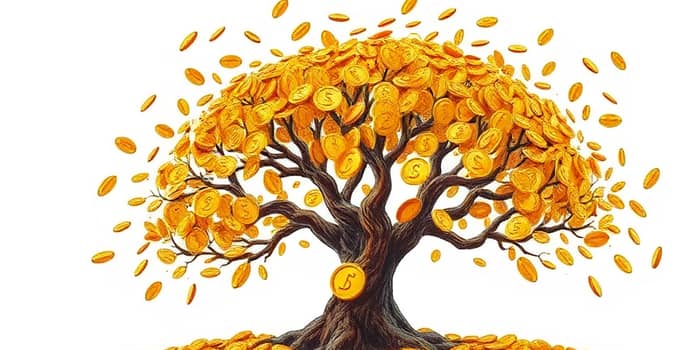Imagine planting a tiny seed today that blossoms into a towering tree decades later. This is the essence of compounding: small beginnings that lead to astonishing results. As Albert Einstein said, compound interest is the eighth wonder of the world, and once you witness its force, you’ll never look at money the same way.
Understanding Compound Interest
At its core, compound interest means earning interest on your principal and on all the interest it has already generated. This process, where each cycle’s gains feed into the next, triggers exponential growth over time. By contrast, simple interest pays you only on the original amount, producing linear, predictable gains.
Consider $10,000 at 8% annual simple interest. You get $800 every year, unchanged. Switch to compounding, and Year Two’s interest is calculated on $10,800, yielding $864. Year Three jumps even more, and so on. That snowball effect underpins the magic that powers your long-term wealth journey.
Mathematical Power Unveiled
Diving into real numbers paints a clear picture. Invest $1,000 at a 5% annual compound rate, and you earn $50 in the first year. The next year, you earn $52.50 because your new base is $1,050. Over two decades, that initial thousand nearly triples.
The standard formula—P × (1 + r/n)^(n×t)—might look daunting, but it encapsulates a simple truth: each variable magnifies returns. More frequent compounding (daily or monthly) squeezes out slightly higher yields, while longer time horizons amplify results dramatically.
Compounding in Practice
Legendary investors like Warren Buffett attribute much of their success to disciplined, long-term compounding. By reinvesting dividends and holding positions for decades, Buffett has let profits snowball, turning modest stakes into multibillion-dollar holdings. Mutual funds, index trackers, and retirement accounts all harness the same principle, allowing everyday investors to ride the wave of market growth.
Dividend reinvestment plans (DRIPs) provide a hands-off method: every dividend automatically purchases more shares, which then generate their own dividends. Over time, this cycle can transform small, regular contributions into substantial nest eggs.
The Time Factor: Early vs. Late Investing
Time is perhaps the most potent ingredient in the compounding recipe. Time is the magic multiplier: each passing year lengthens the compounding chain, causing balances to accelerate dramatically.
Starting at age 25 versus age 35 on a fixed monthly savings plan can yield hundreds of thousands of dollars more by retirement. Even if younger investors save smaller amounts, they benefit from far more compounding periods, underscoring the power of early action.
Compound Interest on Debt: A Warning
Compound interest has a dark side. Credit cards and high-interest loans compound against you, growing balances faster than most people anticipate. A $5,000 balance at 20% APR can snowball out of control if only minimum payments are made.
It’s crucial to avoid high-interest compounding debt or to eliminate it swiftly. Paying more than the minimum, consolidating high-rate debts, or negotiating lower rates can arrest runaway balances and free up resources for productive investments.
Strategies to Maximize Your Compounding
- Start early with small amounts: Regular contributions, even modest ones, grow significantly over decades.
- Reinvest returns for lasting impact: Leave dividends and interest in your account to accelerate growth.
- Automate consistent contributions: Monthly or weekly deposits harness discipline and market timing.
- Choose rewarding investment vehicles: Index funds, bonds, and dividend-paying stocks can all compound effectively.
Overcoming Psychological Barriers
Human nature often underestimates the power of nonlinear growth. We expect predictable, linear increases, and compounding’s curvature can feel counterintuitive. This psychological bias toward linear growth leads many to start too late or give up too soon.
Visual analogies help: imagine a snowball rolling downhill, doubling in size with each rotation. The early revolutions are modest, but soon it becomes unstoppable. Framing compounding this way makes its exponential nature tangible, inspiring patience and persistence.
Conclusion: Embrace the Art of Compounding
Compounding is not a gimmick; it’s a rigorously proven financial principle that rewards patience, discipline, and time. By understanding its mechanics and applying practical strategies, anyone can harness this force to build lasting wealth.
Take action today: open a retirement account, set up automatic transfers, reinvest dividends, and tackle any high-interest debt. Small steps now can lead to monumental outcomes later. Let compounding be your partner on the journey to financial freedom.
References
- https://www.mutualofomaha.com/advice/financial-planning/financial-planning-basics/the-impact-of-compound-interest-on-your-wealth-growth
- https://www.bankhillsboro.com/the-power-of-compound-interest/
- https://www.nasaa.org/investor-education/young-adult-money-mission/compound-interest-2/
- https://www.carterwealth.com/insights/the-power-of-compound-interest-a-simple-path-to-wealth/
- https://www.ccu.com/learn/banking-basics/what-is-compound-interest/
- https://www.fiducientadvisors.com/blog/the-power-of-compounding-how-time-can-be-your-best-investment-ally
- https://www.juliusbaer.com/en/insights/wealth-insights/how-to-invest/compound-interest-the-engine-of-wealth-creation/
- https://www.wellsfargo.com/financial-education/investing/compound-interest-growth/










